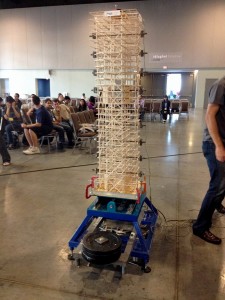The Seismic Design Competition team with their 29-story balsa wood model.
CEE’s Earthquake Engineering Research Institute (EERI) student chapter placed sixth in this year’s Seismic Design Competition in Alaska in 2014 with a 29-story model building that withstood three simulated earthquakes.
During the competition, buildings from more than 30 student groups were placed on a shake table to see how they would react to the different ground motions.
Judges scored teams based on the structure’s performance while also considering architecture, a poster presentation and calculations of each building’s potential for rental revenue and the estimated cost of any damage.
“We used squares, octagons and crosses for floor plans to maximize space and get as much revenue as possible,” said Antonella Ungari, one the students who led this year’s group. “To resist the earthquakes, we used crossbracing on the outer part of the structure and shear walls up the third floor to better attach the building to the base plate.”
That work paid dividends, keeping the structure from collapsing–a huge improvement from recent years, when the CEE team’s building failed at some point during the tests. The group finished in 35th place a year ago.
“We wanted to make things different this year,” Ungari said. She participated last year, too, and said the team paid particular attention this time around to the strict construction rules for the competition and the torsion of their building during a simulated earthquake.
The Seismic Design Competition happens each year at EERI’s annual meeting. Its goals are to encourage undergraduates to study earthquake engineering and give them an opportunity to work on a hands-on design and construction project.
(http://ce.gatech.edu/media/news/6427)


